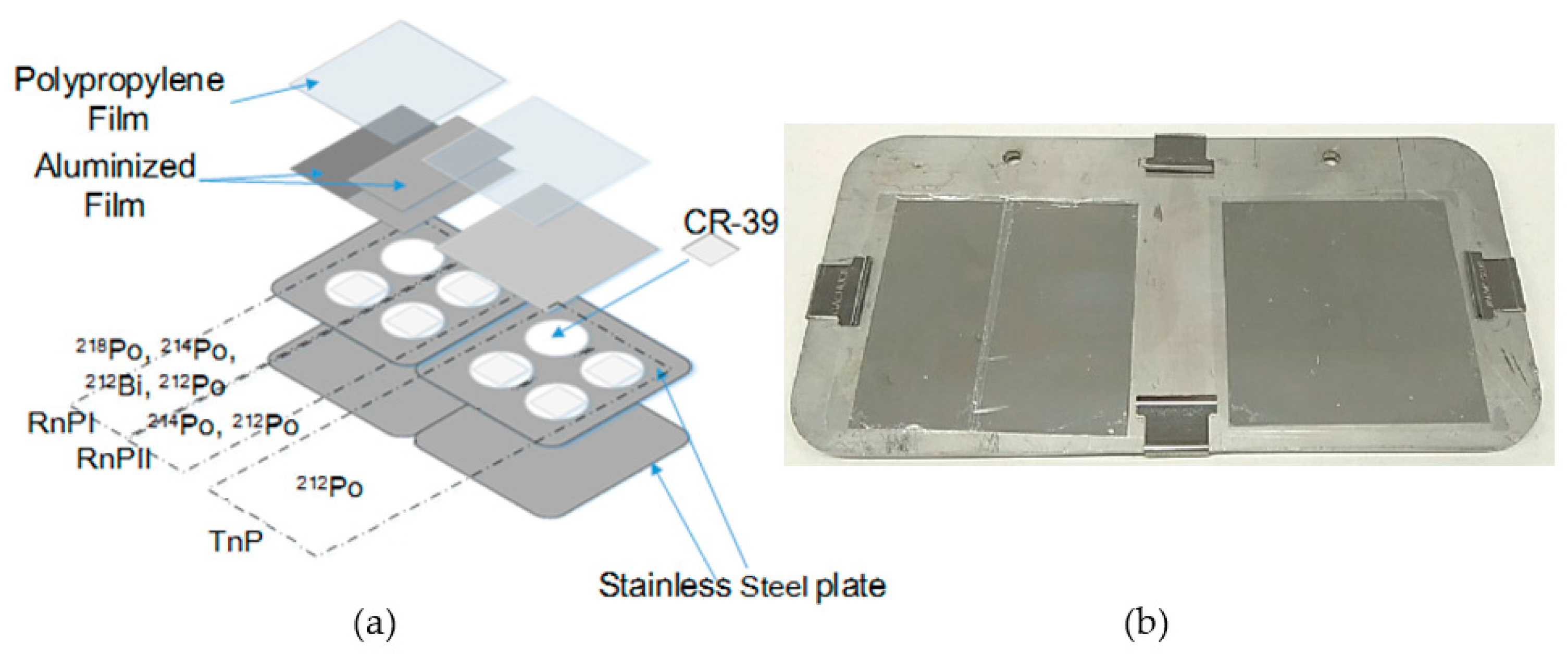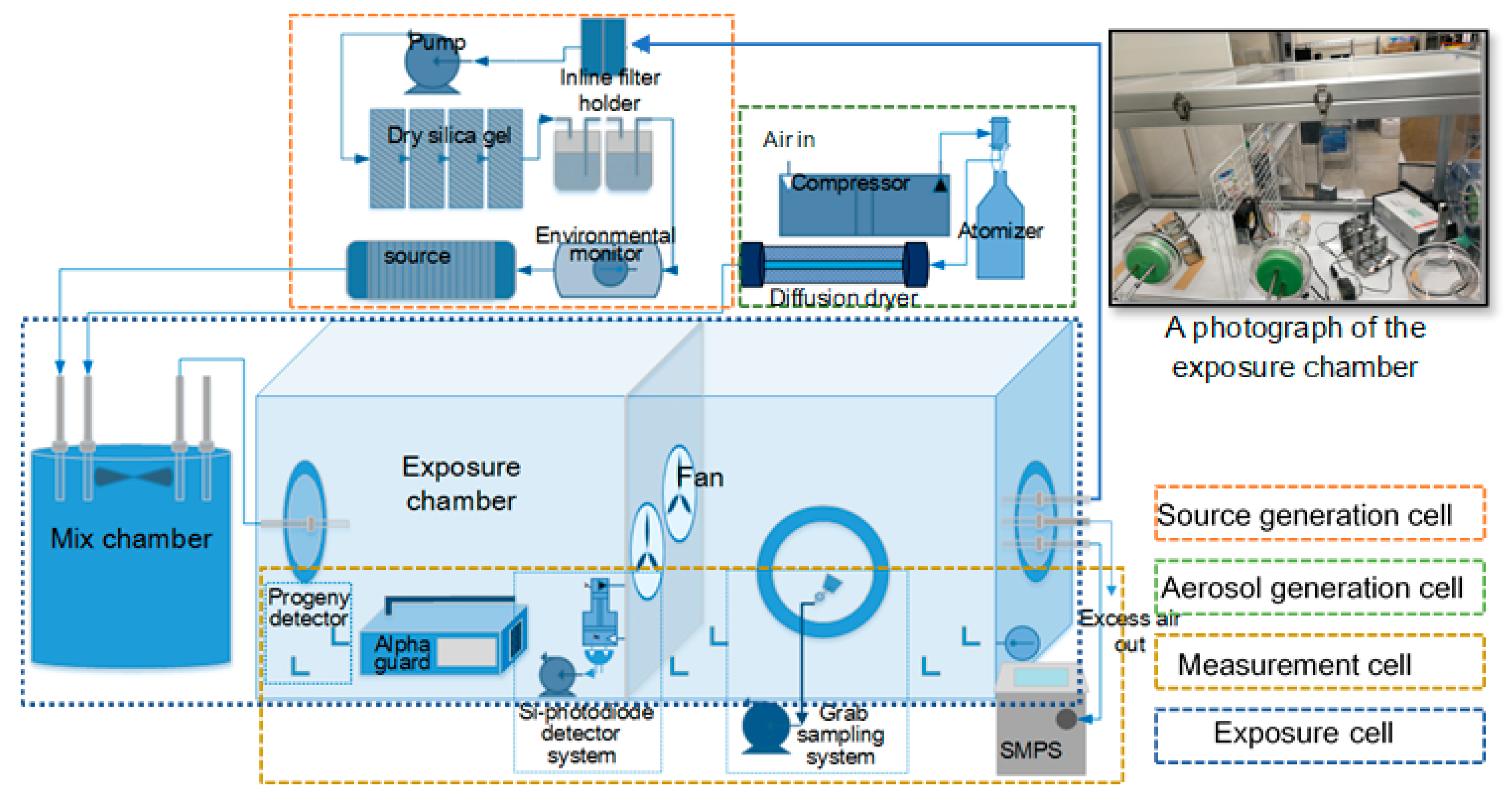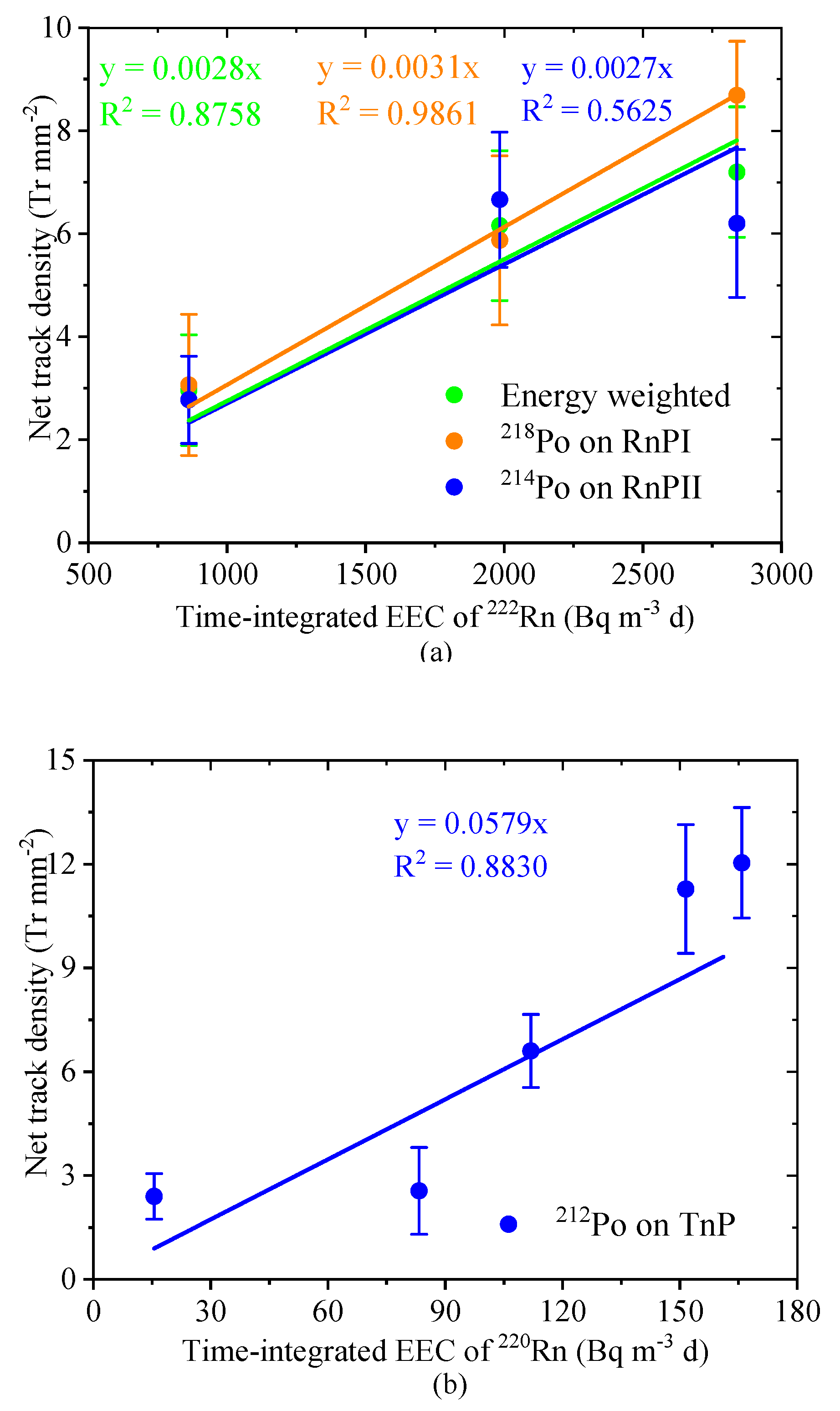An Improved Passive CR-39-Based Direct 222Rn/220Rn Progeny Detector
Abstract
1. Introduction
2. Materials and Methods
2.1. The Passive CR-39-Based Direct 222Rn/220Rn Progeny Detector
2.2. The Theoretical Model and Parameters
2.2.1. Theoretical Model
2.2.2. Parameters Estimation
Deposition Velocity
Parameters in the Jacobi Room Model
3. Results and Discussion
3.1. The Comparison of Chamber Test with a Theoretical Model
3.2. Comparison of the Estimated Deposition Velocities with Previous Studies
3.3. The Relationship between NTD and Time-Integrated EEC
4. Conclusions
Author Contributions
Funding
Conflicts of Interest
References
- Tokonami, S.; Takahashi, H.; Kobayashi, Y.; Zhuo, W.; Hulber, E. Up-to-date radon-thoron discriminative detector for a large scale survey. Rev. Sci. Instrum. 2005, 76, 113505. [Google Scholar] [CrossRef]
- Eappen, K.; Mayya, Y. Calibration factors for LR-115 (type-II) based radon thoron discriminating dosimeter. Radiat. Meas. 2004, 38, 5–17. [Google Scholar] [CrossRef]
- Sciocchetti, G.; Sciocchetti, A.; Giovannoli, P.; DeFelice, P.; Cardellini, F.; Cotellessa, G.; Pagliari, M. A new passive radon-thoron discriminative measurement system. Radiat. Prot. Dosim. 2010, 141, 462–467. [Google Scholar] [CrossRef] [PubMed]
- Sahoo, B.; Sapra, B.; Kanse, S.; Gaware, J.; Mayya, Y. A new pin-hole discriminated 222Rn/220Rn passive measurement device with single entry face. Radiat. Meas. 2013, 58, 52–60. [Google Scholar] [CrossRef]
- Guo, Q.; Iida, T.; Okamoto, K.; Yamasaki, T. Measurements of thoron concentration by passive cup method and its application to dose assessment. J. Nucl. Sci. Technol. 1995, 32, 794–803. [Google Scholar] [CrossRef]
- Hu, J.; Yang, G.; Hegedűs, M.; Iwaoka, K.; Hosoda, M.; Tokonami, S. Numerical modeling of the sources and behaviors of 222 Rn, 220 Rn and their progenies in the indoor environment—A review. J. Environ. Radioact. 2018, 189, 40–47. [Google Scholar] [CrossRef]
- Zhuo, W.; Iida, T. Estimation of thoron progeny concentrations in dwellings with their deposition rate measurements. Jpn. J. Health Phys. 2000, 35, 365–370. [Google Scholar] [CrossRef]
- Tokonami, S.; Sun, Q.; Yonehara, H.; Yamada, Y. A Simple Measurement Technique of the Equilibrium Equivalent Thoron Concentration with a CR-39 Detector. Jpn. J. Health Phys. 2002, 37, 59–63. [Google Scholar] [CrossRef]
- Zhuo, W.; Tokonami, S. Convenient methods for evaluation of indoor thoron progeny concentrations. Int. Congr. Ser. 2005, 1276, 219–220. [Google Scholar] [CrossRef]
- Tokonami, S. Why is 220Rn (thoron) measurement important? Radiat. Prot. Dosim. 2010, 141, 335–339. [Google Scholar] [CrossRef]
- Sorimachi, A.; Tokonami, S.; Kranrod, C.; Ishikawa, T. Preliminary Experiments Using a Passive Detector for Measuring Indoor 220Rn Progeny Concentrations with an Aerosol Chamber. Health Phys. 2015, 108, 597–606. [Google Scholar] [CrossRef] [PubMed]
- Hu, J.; Hosoda, M.; Tokonami, S. Parameter sensitivity analysis of the theoretical model of a CR-39-based direct 222Rn/220Rn progeny monitor. Nukleonika 2020, 65, 95–98. [Google Scholar] [CrossRef]
- Mishra, R.; Mayya, Y.S. Study of a deposition-based direct thoron progeny sensor (DTPS) technique for estimating equilibrium equivalent thoron concentration (EETC) in indoor environment. Radiat. Meas. 2008, 43, 1408–1416. [Google Scholar] [CrossRef]
- L’Annunziata, M.F. Handbook of Radioactivity Analysis: Radiation Physics and Detectors, 4th ed.; Academic Press: Cambridge, MA, USA, 2020; pp. 318–332. [Google Scholar]
- Mishra, R.; Mayya, Y.; Kushwaha, H. Measurement of 220Rn/222Rn progeny deposition velocities on surfaces and their comparison with theoretical models. J. Aerosol Sci. 2009, 40, 1–15. [Google Scholar] [CrossRef]
- Jacobi, W. Activity and potential α-energy of 222Rn and 220Rn-daughters in different air atmospheres. Health Phys. 1972, 22, 441–450. [Google Scholar] [CrossRef] [PubMed]
- Lai, A.C.K.; Nazaroff, W.W. Modeling indoor particle deposition from turbulent flow onto smooth surfaces. J. Aerosol Sci. 2000, 31, 463–476. [Google Scholar] [CrossRef]
- Corner, J.; Pendlebury, E.D. The coagulation and deposition of a stirred aerosol. Proc. Phys. Soc. B 1951, 64, 645–654. [Google Scholar] [CrossRef]
- Porstendörfer, J. Behaviour of radon daughter products in indoor air. Radiat. Prot. Dosim. 1984, 7, 107–113. [Google Scholar] [CrossRef]
- Porstendörfer, J.; Röbig, G.; Ahmed, A. Experimental determination of the attachment coefficients of atoms and ions on monodisperse. J. Aerosol Sci. 1979, 10, 21–28. [Google Scholar] [CrossRef]
- Porstendörfer, J. Radon: Measurements related to dose. Environ. Int. 1996, 22, 563–583. [Google Scholar] [CrossRef]
- Stevanovic, N.; Markovic, V.M.; Nikezic, D. Relationship between deposition and attachment rates in Jacobi room model. J. Environ. Radioact. 2010, 101, 349–352. [Google Scholar] [CrossRef] [PubMed]
- Tokonami, S.; Ichiji, T.; Iimoto, T.; Kurosawa, R. Calculation procedure of potential alpha energy concentration with continuous air sampling. Health Phys. 1996, 71, 937–943. [Google Scholar] [CrossRef] [PubMed]
- Tamakuma, Y.; Yamada, R.; Iwaoka, K.; Hosoda, M.; Kuroki, T.; Mizuno, H.; Yamada, K.; Furukawa, M.; Tokonami, S. A portable radioactive plume monitor using a silicon photodiode. Perspect. Sci. 2019, 12, 100414. [Google Scholar] [CrossRef]
- Shimada, M.; Okuyama, K.; Kousaka, Y.; Seinfeld, J.H. A model calculation of particle deposition onto a rough wall by Brownian and turbulent diffusion. J. Colloid Interface Sci. 1988, 125, 198–211. [Google Scholar] [CrossRef]
- Hu, J.; Sun, L.; Li, C.H.; Wang, X.; Jia, X.L.; Cai, Y.P. Water quality risk assessment for the Laoguanhe River of China using a stochastic simulation method. J. Environ. Inform. 2018, 31, 123–136. [Google Scholar] [CrossRef]
- Bigu, J. Radon daughter and thoron daughter deposition velocity and unattached fraction under laboratory-controlled conditions and in underground uranium mines. J. Aerosol Sci. 1985, 16, 157–165. [Google Scholar] [CrossRef]



| Channel | Membrane Thickness (mg cm−2) | Nuclide | Energy of α-Particle (MeV) | Track Registration Efficiency, η | Deposited Atoms |
|---|---|---|---|---|---|
| TnP | 7.10 | 212Po | 8.785 | 0.063 | 212Pb, 212Bi |
| RnPII | 5.05 | 212Po | 8.785 | 0.212 | 212Pb, 212Bi |
| 214Po | 7.687 | 0.182 | 218Po, 214Pb, 214Bi | ||
| RnPI | 3.25 | 212Po and 212Bi | 8.785 and 6.051 | 0.152 | 212Pb, 212Bi |
| 214Po | 7.687 | 0.249 | 218Po, 214Pb, 214Bi | ||
| 218Po | 6.003 | 0.135 | 218Po |
| Model | Experiment | Model | Experiment | ||
|---|---|---|---|---|---|
| Exposure time (h) | 25.5 | 36.9 | |||
| The number concentration (N cm−3) | 27,297 | 30,417 | |||
| GSD, σg | 1.506 | 1.613 | |||
| CMD (μm) | 0.203 | 0.203 | |||
| Track density (tr mm−2) | Upward | 3.9 | 2.9 | ||
| Vertical | 4.3 | 4.8 | |||
| Deposition velocity (m h−1) | Upward | 0.185 | 0.143 ± 0.029 | 0.243 | 0.193 ± 0.067 |
| Vertical | 0.169 | 0.158 ± 0.040 | 0.238 | 0.217 ± 0.045 | |
| 212Pb | 0.185 | —— | 0.219 | —— | |
| 212Bi | 0.132 | —— | 0.183 | —— | |
| Deposition flux (atoms cm−2 s−1) | Upward | 0.081 | 0.081 | 0.055 | 0.069 |
| Vertical | 0.090 | 0.090 | 0.042 | 0.042 | |
| EEC of 220Rn (Bq m−3) | Upward | 237 ± 88 | 244 ± 108 1 | 148 ± 38 | 155 ± 67 1 |
| Vertical | 263 ± 88 | 188 ± 50 | |||
| Model | Experiment | Model | Experiment | Model | Experiment | |||
|---|---|---|---|---|---|---|---|---|
| Exposure time (h) | 30 | 70 | 102 | |||||
| Concentration of nuclei number (N cm−3) | 34,528 | 33,833 | 33,278 | |||||
| GSD, σg | 1.714 | 1.761 | 1.768 | |||||
| CMD (μm) | 0.233 | 0.200 | 0.191 | |||||
| Track density (tr mm−2) | Upward | RnPI | 6.3 ± 1.3 | 16.4 ± 2.5 | 14.9 ± 2.3 | |||
| RnPII | 4.5 ± 1.2 | 6.2 ± 1.6 | 4.9 ± 1.1 | |||||
| Vertical | RnPI | 7.4 ± 1.5 | 13.6 ± 2.1 | 17.2 ± 2.7 | ||||
| RnPII | 1.1 ± 0.8 | 7.1 ± 1.8 | 5.9 ± 1.3 | |||||
| Deposition velocity (m h−1) | Upward | 0.136 | —— | 0.123 | —— | 0.125 | —— | |
| Vertical | 0.131 | —— | 0.117 | —— | 0.119 | —— | ||
| 218Po | 0.290 | —— | 0.248 | —— | 0.230 | —— | ||
| 214Pb | 0.155 | —— | 0.135 | —— | 0.112 | —— | ||
| 214Bi | 0.101 | —— | 0.091 | —— | 0.092 | —— | ||
| Deposition flux (atoms cm−2 s−1) | 218Po to RnPI | Upward | 0.041 | 0.051 ± 0.010 | 0.022 | 0.048 ± 0.017 | 0.018 | 0.030 ± 0.016 |
| Vertical | 0.043 ± 0.009 | 0.040 ± 0.014 | 0.035 ± 0.019 | |||||
| 218Po, 214Pb, 214Bi to RnPII | Upward | 0.014 | 0.005 ± 0.004 | 0.011 | 0.014 ± 0.008 | 0.008 | 0.007 ± 0.006 | |
| Vertical | 0.023 ± 0.006 | 0.016 ± 0.009 | 0.009 ± 0.007 | |||||
| EEC of 222Rn (Bq m−3) | Upward | 1214 ± 322 | 740 ± 27 1 | 730 ±290 | 693 ±16 1 | 758 ± 370 | 686 ± 31 1 | |
| Vertical | 267 ± 187 | 603 ±312 | 630 ± 375 | |||||
| Reference | Deposition Velocity (m h−1) | Remark | |
|---|---|---|---|
| RnP Detector | TnP Detector | ||
| [27] | 8.64 | 19.08 | Fan on, 26 m3 test facility |
| 3.24 | 2.16 | Fan off, 26 m3 test facility | |
| [7] | 0.19 ± 0.04 | Dwelling, the same structure of TnP detector as this study | |
| [15] | 0.132 ± 0.0036 | 0.075 ± 0.0072 | 22.5 m3 test room |
| 2.37 ± 0.785 | 0.5 m3 chamber | ||
| 0.117 | 0.072 | Dwelling | |
| [11] | 0.828 ±0.072 | 150 L chamber, same TnP detector as this study | |
| This study | 0.125 ± 0.007 | 0.178 ± 0.045 | 3.24 m3 chamber |
Publisher’s Note: MDPI stays neutral with regard to jurisdictional claims in published maps and institutional affiliations. |
© 2020 by the authors. Licensee MDPI, Basel, Switzerland. This article is an open access article distributed under the terms and conditions of the Creative Commons Attribution (CC BY) license (http://creativecommons.org/licenses/by/4.0/).
Share and Cite
Hu, J.; Yang, G.; Kranrod, C.; Iwaoka, K.; Hosoda, M.; Tokonami, S. An Improved Passive CR-39-Based Direct 222Rn/220Rn Progeny Detector. Int. J. Environ. Res. Public Health 2020, 17, 8569. https://doi.org/10.3390/ijerph17228569
Hu J, Yang G, Kranrod C, Iwaoka K, Hosoda M, Tokonami S. An Improved Passive CR-39-Based Direct 222Rn/220Rn Progeny Detector. International Journal of Environmental Research and Public Health. 2020; 17(22):8569. https://doi.org/10.3390/ijerph17228569
Chicago/Turabian StyleHu, Jun, Guosheng Yang, Chutima Kranrod, Kazuki Iwaoka, Masahiro Hosoda, and Shinji Tokonami. 2020. "An Improved Passive CR-39-Based Direct 222Rn/220Rn Progeny Detector" International Journal of Environmental Research and Public Health 17, no. 22: 8569. https://doi.org/10.3390/ijerph17228569
APA StyleHu, J., Yang, G., Kranrod, C., Iwaoka, K., Hosoda, M., & Tokonami, S. (2020). An Improved Passive CR-39-Based Direct 222Rn/220Rn Progeny Detector. International Journal of Environmental Research and Public Health, 17(22), 8569. https://doi.org/10.3390/ijerph17228569








